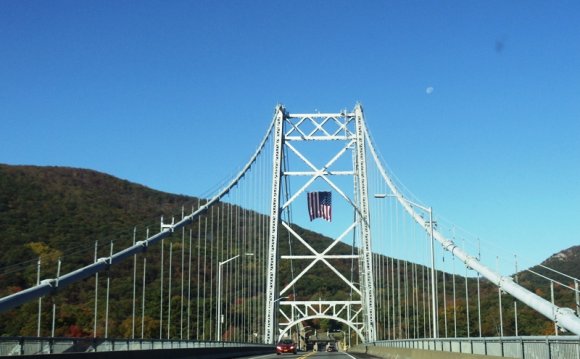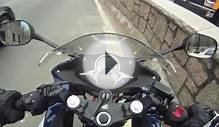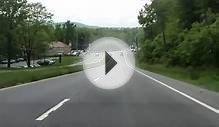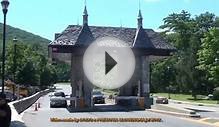|
|
|
|
|
|
|
|
|
|
|
|
This 2004 photo shows the Bear Mountain Bridge (US 6 and US 202) from the western shoreline, just above the Orange-Rockland county line. (Photo by C.C. Slater.)
|
|
|
|
|
|
|
|
|
|
|
|
CROSSING THE HIGHLANDS: The Bear Mountain Bridge, the southernmost crossing administered by the New York State Bridge Authority, carries US 6 and US 202 across the Hudson River, from Bear Mountain State Park at the northern tip of Rockland County to the northwestern corner of Westchester County. On the western approach, which actually lies in Orange County (the Orange-Rockland border runs diagonally between the toll plaza and the superstructure), the bridge connects to US 9W and the Palisades Interstate Parkway. On the eastern approach, the bridge connects to NY 9D.
|
|
|
|
|
|
|
Plans for the bridge date as far back as 1868, when the first charter for a railroad bridge was obtained. The initial proposal by General Edward W. Serrell, which was featured in a Harper's Weekly article, employed a suspension span design similar to that of the Brooklyn Bridge. The truss-stiffened deck was to be supported over the Hudson River by four main cables and two masonry towers. Despite three attempts at starting construction, none of them got past the initial stages.
As the twentieth century began, private ferry companies initiated passenger service in the Highlands. When nearby Bear Mountain State Park opened in 1916, it quickly became a popular destination for New Yorkers. Before long, getting to and from the park meant long delays at the ferry terminal, or during nighttime or winter periods, not getting across at all. Even when they were available, ferries crossing the river between Peekskill and Bear Mountain State Park had waits of as much as four hours.
In February 1922, a bill was introduced in the New York State Legislature that authorized the creation of a privately financed entity, the Bear Mountain Hudson Bridge Company, to build a vehicular bridge across the Hudson at Bear Mountain. Under the terms of this bill, the company was given 30 years to build and maintain the bridge and highway approaches on state-owned land, after which time the state would take over the bridge. The most practical location for a bridge was at the narrow entrance to the Highlands. (At that time, there were no fixed vehicular crossings of the Hudson River south of Albany.)
DESIGN AND CONSTRUCTION OF THE BRIDGE: The time limit on construction of the bridge meant that steel rather than masonry would have to be used. However, new developments in obtaining geological data and steel construction technology provided the time and cost efficiencies that eluded previous construction attempts.
There were also concerns about how the bridge and highway design would impact the beauty of the lower Hudson Valley. After criticism that the proposed bridge would look "in its wonderful setting of mountains and river, like a piece of tin frumpery, " consulting engineer Howard C. Baird modified its design to better fit in its surroundings.
|
|
|
|
|
|
|
|
|
Construction of the bridge began in March 1923. The anchorages that hold the two main steel cables were dug manually out of solid rock at a rate of approximately eight feet per week. The west anchorage was dug 110 feet into the rock, and the east anchorage 90 feet into the rock. Once the anchorages were completed in October 1923, work began on the two 351-foot-tall towers. The steel towers, which are supported by horizontal and diagonal braces rest on cast steel bases, which in turn rested on concrete piers (each measuring 20 feet by 50 feet) founded on rock near water level. The towers were completed in April 1924.
|
|
|
|
|
|
|
|
|
|
|
Source: www.nycroads.com
RELATED VIDEO
CBR250R Bear Mountain - Part Two
US 9W (Newburgh to Bear Mountain) southbound
BEAR MOUNTAIN BRIDGE toll gate rockland to westchester ...
|







